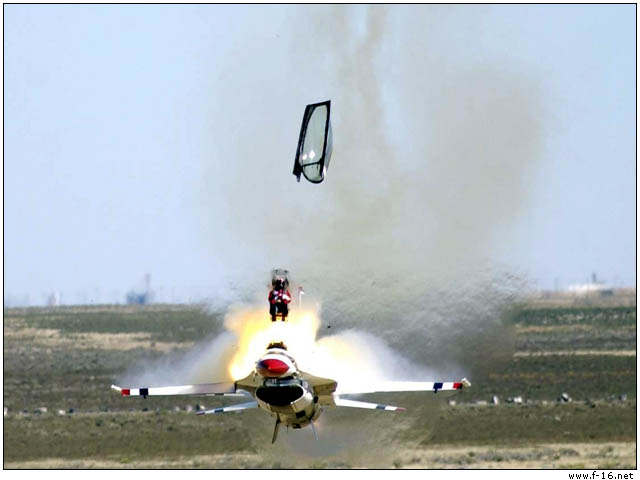
Pilot ejects 0.8 seconds before the jet impacts the ground. [Photo by SSgt Bennie J. Davis III - Still Photographer, USAF]
Comments
-
Kevin (kmceject)
He'd be experiencing about 10-14Gzs depending on his mass, but at this point the rockets are at or near burn-out so the Gz pulse is fading quickly.
Kevin
-
adres100@adres.nl
And if the plane was already in an high G pull-up, his G accelleration relative to the ground is not that much. Bumpy landing -
David Emerling
I ejected from a Navy TA-4 (Martin-Baker ejection seat). I was told that the instantaneous G's were well over a 100. That alone would kill you if didn't go away almost instantly. The Navy had an ejection trainer but it is mostly for procedures. It doesn't even come close to simulating the tremendous forces involved. It is literally like being shot out of a canon. Ironically, once I had ejected I always had a deeper apprehension for the prospective of doing it again instead of having any secure feeling about how the system works. It works ... but it's no fun to experience. My ejection occurred in south Texas, near a little town called San Diego. -
laruud@mil.no
As a F-16 mech.I am impressed by the way this picture shows the very fast secvenses that rescued the pilot.When he pulled the handle he fired a detonating fuse and two rockets that blew the canopy away.The canopy has two steelwires that triggers the ejecting rocket when stretched,and out you go!Already in this picture the gyro is working,the pitot tubes are measuring the air speed,a small rocket are moving him sideways to the left and the altimeter is telling the chair to open the chute as quick as H....!Impressing! -
KTMNealio@yahoo.com
The has to be the most surreal moment I have ever experienced. I thought for sure it was some kind of planned event; like they were dropping a fuel tank or soemthing. When I saw the engine cart-wheeling through the air I knew it was real. Talk about chaos afterwards though!
- Nealio -
Steve Timmermans (Timmer)
Seen from a photographers point of view: this is one h*** of a picture!
From a plane lover's point of view:
Damn, why did it have to hit the ground... Could he have made it if he started the split S 200ft higher? -
cargot
That's what the accident board seemed to think. From elsewhere on this website: "A pilot's error caused a Thunderbirds F-16C to crash shortly after takeoff during a September airshow at Mountain Home Air Force Base, Idaho...The pilot incorrectly climbed to 1,670 feet above ground level instead of 2,500 feet before initiating the pull down to the Split S maneuver." -
zenpilot
There is also in plane camera footage @ http://proairshow.com/mountainhome.htm if you got to the in Cockpit video and slow it down at the end you can see all this, even him reaching for the eject handle, in frame by frame. -
Jeremy Elliott (Idahoff)
I too was at this airshow. As soon as he rolled out into the dive you could tell something was wrong. For a second I couldnt believe what I was seeing. It all happened so fast I dont even remember hearing an explosion or anything. Shortly after Capt. Striclin hit the ground he stood up and waved to the crowd and then collapsed back down. Minor injuries only. -
Philippe (phil)
3 inches?? Are you sure it's that much? I tought it was more like 1,2 inches (3 cm). And will he get them back after a while? -
354egress
I have to say that laruud is a little inaccurate about the ejection system. First, when the ejection handle is pulled, two initiators are fired, one fires the inertia reel gas generator which pulls the pilot back into the seat, the other sends gas pressure into the seat rails and initiates the DTA (detonation transfer assembly)lines which send an explosive charge to the canopy, which DOES fire two rockets to remove the canopy. The pitot tubes DO sense altitude and airspeed. But there are no "altimeters" telling the seat when to fire the chute or release the survival kit. -
16 Chief
Actually during the ejection sequence there are 3 modes that the seat will fall into once it gets air through the pitot tubes...and from that it decides when to throw the chute. Below 15,000 feet and below 300knots its mode 1, below 15,00 and above 300knots mode 2, and above 15,000 and above 300 knots mode 3. Only difference in the modes is the time in which the different events happen. And it compresses your spine approx. 1/2" every time you eject...not 3" -
anotherF-16crewchief
if you have or get a chance to listen to the ground audio/video you'll clearly hear him say, "six on top 3-5" whether or not he truly thought he was at the proper altitude is something only he knows...
Link this photo
- Use in a forum post
- Use to link from other websites
